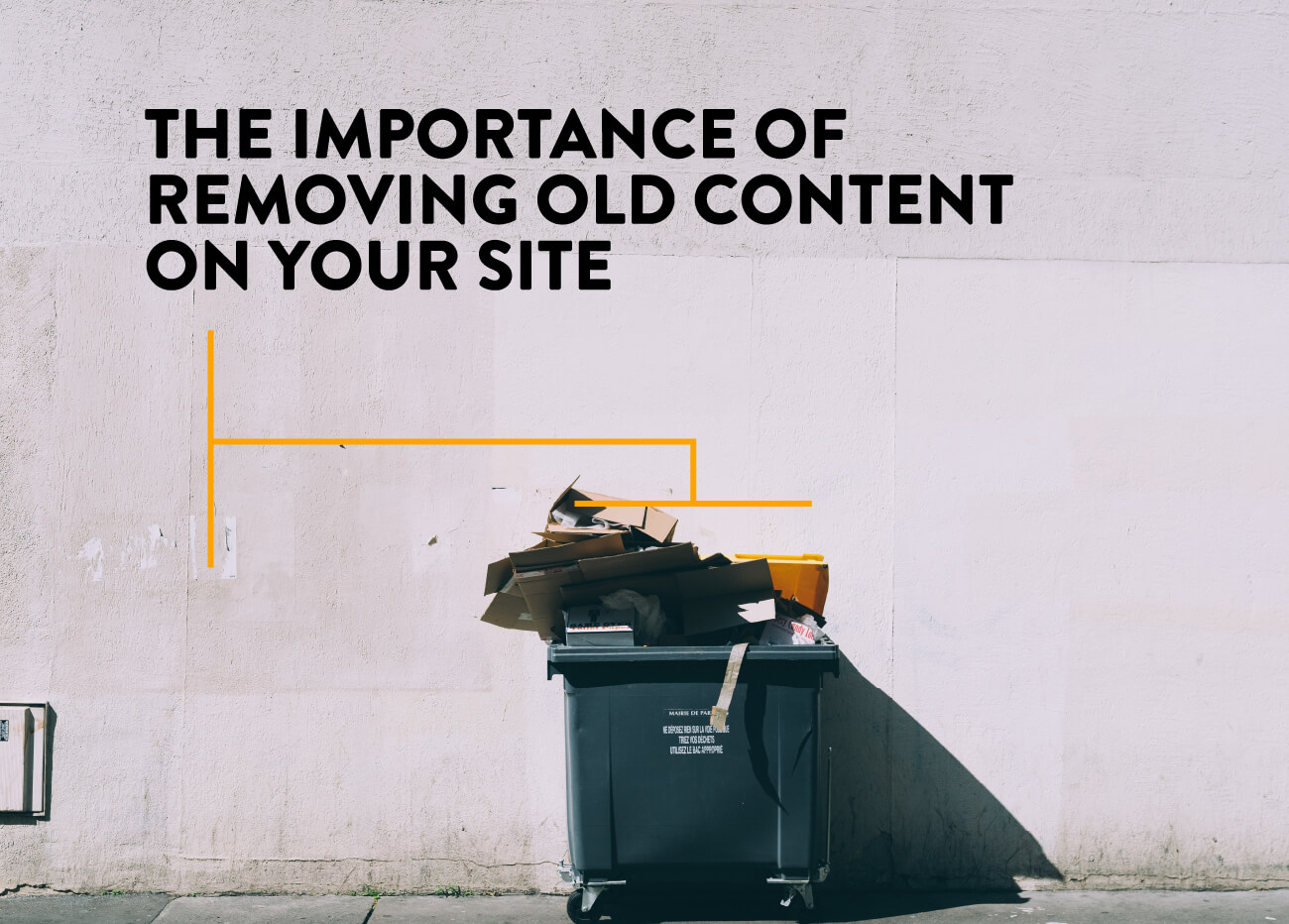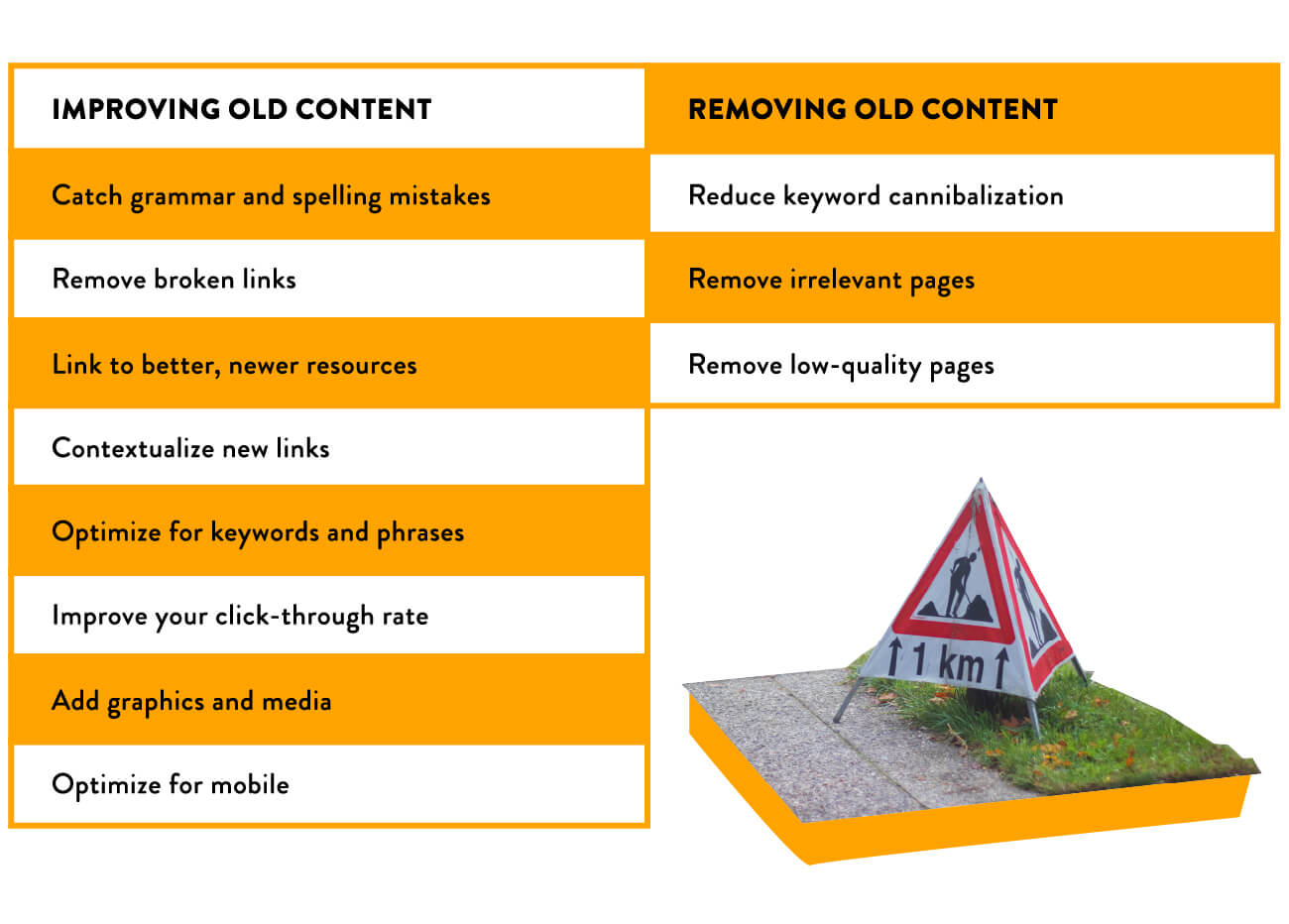Sometimes the search engine optimization (SEO) solution a company needs most is right under their nose — or literally speaking, right under their URL. Think about all the old content you may have on your site. When’s the last time you checked in on it? If the answer is anything more than, say, six months, it’s time to give it another look.

Content that once ranked on page one of the search engine results pages (SERPs) naturally diminishes in value over time. While you may have written a great piece of content in 2017, who knows how many competitors have gone back and created something newer and better since then — or, as we’re suggesting here, revised their old work in order to outrank yours.
The best solution is not always the one that is going to require an entirely new set of keywords, technical expertise, or an understanding of the inner workings of search engines. Displaying better, fresher content on your site may be as simple as contextualizing new links or removing low-quality pages. Practices that require subject matter expertise, rather than SEO expertise, can go a long way in boosting your traffic.
What Is Content Freshness?
Imagine if the news was never updated. Would you want the same story every day? The same applies to a site’s content. While content doesn’t need to be updated every single day — like, say, the news does — it needs periodic sweeps so that it may stay “fresh.”
Fresh content refers to dynamic content. It doesn’t necessarily have to be associated with frequency, though the terms aren’t mutually exclusive either. Let’s not forget to mention, content freshness is one of many ranking factors for Google. It’s called Query Deserved Freshness (QDF). How QDF works is that the SERPs give priority to pages that fit the most recent search intention. So if your content isn’t updated with the relevant keywords or doesn’t match the intent and expectations of searchers, it isn’t going to perform as well as it once may have.
Why You Don’t Always Need New Content
“Content is king” is true — but only if the content you are publishing is useful, relevant, and fresh. Too often content is conflated with quantity over quality, or creation over revision: the more content the better. The less content the worse. But this isn’t necessarily the case.
There’s a time and a place for new content and figuring that out is a key part of boosting your SEO rankings. So, when should you create new content and when should you revise old content? This can depend on a few matters.
How old is your site? If you’ve been publishing content for 3, 5, or even 10 years, there’s a good chance it needs some revising. Similarly, if you began publishing content on your site without any knowledge of SEO, there’s a good chance you didn’t implement any search-related best practices.
Fledgling sites with minimal content or older sites looking to target new keywords or expand link-building opportunities are more likely to benefit from content creation services than the other examples given.
Old Content: To Improve or Remove?
If you’ve decided that content revision is a better plan of action than content creation then the next question follows: should you improve or remove the old content?
Removal may be necessary when link-building opportunities on a page are poor and content is deemed unsalvageable. Alternatively, removal may be necessary when there is no keyword value associated with the topic. That being said, you always have to remember the purpose of a given page. After all, a product page isn’t linkable, but it does belong on your site.
The action of removing content from your site is typically due to one or more of these core reasons: cannibalization, irrelevance, and quality. Conversely, content needs improvements essentially whenever it doesn’t deserve to be removed, but could benefit from being revised.
Below is a quick chart depicting the benefits of each:

How Removing Old Content Helps Your Site
Removing old content is referred to as “content pruning” in the SEO world. When gardening, pruning can both look and feel destructive, but when done properly actually stimulates growth and supports plant health. The same is true for websites that undergo content pruning.

Benefits of content pruning include enhancing the overall quality of your site, improving your user experience, and making better use of your crawl budget — that being, the time and resources search engines spend crawling your website and recording their findings in their indexes.
Reduce Keyword Cannibalization
Targeting a specific keyword phrase across multiple pages doesn’t help your rankings as you may think. When you use a keyword phrase too many times, you’re competing with yourself — lowering your authority more than you would if you had one consolidated page.
Plus, Google announced in 2019 that its algorithm is working to remove duplicate listings from a single domain, to promote site diversity.
If you’re looking to publish a new piece of content, make sure you don’t already have an article targeting the same keywords you’d be using. If you do, consider simply removing the page.
Remove Irrelevant Pages
Irrelevant, invaluable pages serve no purpose for readers or search engine crawlers. Rather, they waste crawler time and attention with pages that offer little keyword value, link networking, or traffic conversion. The more you waste the crawl budget of your site, the less often search engines are going to revisit it and index content for ranking purposes.
Product pages for items you discontinued, for instance, should be removed. You may also wish to remove irrelevant headers or sections from otherwise useful pieces of content.
Remove Low-Quality Pages
Similar to irrelevant pages, low-quality pages also serve no purpose on your site. These pages perform poorly in several ways; they rank for no meaningful keywords, draw limited to no traffic, and fail to provide any link-building opportunities.
Not all pages must have SEO value to make the cut though. Content that performs well on social media, draws traffic, or provides updates to loyal clients should absolutely be kept. All things considered, you need to have a good reason behind every page on your site. If you don’t have a good reason, it may be time to place a given page on the chopping block.
How Improving Old Content Helps Your Site

Besides the QDF ranking, there are myriad other benefits to enjoy by improving content on your site. Benefits largely revolve around an improved user experience and better-implemented SEO tactics.
Catch Grammar and Spelling Mistakes
Grammar and spelling are not direct ranking factors for Google, but error-free content is an important aspect of the user experience. Too many misspelled words can foster a negative user experience, which can ultimately impact your rankings. Going through old content provides you the opportunity to catch these kinds of mistakes.
You may also benefit from revising your writing to make it more clear and concise. Give it a good read-through to find any excessively long sentences, rambling, or disjointed language that needs to be removed.
Remove Broken Links
A helpful resource you linked to years ago may no longer exist or might have moved, resulting in what’s known as a broken link. Not only does this hurt your rankings, but it also diminishes the overall user experience. Nobody wants to find a broken link when they expect a resource.
Luckily, broken links aren’t too hard to fix. For sites operating on Google, try the broken link checker for an easy-to-use tool. A full-scale technical SEO audit of your site can also help you find any issues with links, among other issues that may need attention as part of a content refresh.
Link to Better, Newer Resources
Data is essential to back up any claims made in a piece of content, but data can quickly become outdated. If you wrote an article in 2015, you may have cited a resource from 2012. Odds are that newer and better data is now available. Your old resources could be reporting outdated information or even something that has since been proven false.
Any piece of content requiring citations should be marked up as a page for potential revision in the future. Research is constantly being updated so make your content keeps up.
Contextualize New Links
In addition to including new resources, you can also improve your web of internal links. Think about all the content you’ve created over the years. Your top-performing content from however long ago can be used to highlight newer pages. Simply contextualize new links on old pages to reinforce your overall link-building campaign and increase your search engine traffic.
Optimize for Keywords and Phrases
Searcher behavior changes over time, and what might have been a valuable keyword phrase five years ago may not be today. In other words, keyword research performed in the past doesn’t always present the best opportunities for contemporary searchers. Revising old content provides you a chance to reevaluate your strategy and optimize for today’s keywords and phrases, and the underlying searcher intent behind them.
Improve Your Click-through Rate
The top search results usually consist of content published in the last few years, depending on the urgency of the query. As the times change, information becomes more available — and people are more likely to click on articles that were recently published. This all comes back to content freshness.
For sites that have been around for a while now, revisions are vital to improving your click-through rate. But a date change isn’t the only advantage. Your site may also benefit from an updated title tag and meta description. For a click-worthy meta description, write something that is to the point but promises more detail and value will be on the page.
Add Graphics and Multimedia

Five years ago you may not have had the budget for graphics or other rich media. If you do today, incorporating different types of media is a must. From images to videos, these forms of art typically attract more links than pages without any graphic content — and links, of course, reflect well on the value and trustworthiness of your site to search engines.
Optimize for Mobile
Especially old content may not be optimized for mobile devices. Revising your site’s content to make sure that it is accessible to mobile users will greatly expand your audience. This may be more of a technical, back-end issue than one of the content itself, but changing your site or page design can also be an opportunity to review all the above to-do items and ensure that your site is fully optimized from end-to-end.

